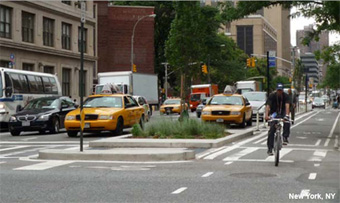The National Association of City Transportation Officials' Urban Bikeway Design Guide was 20 years in the making, and already it's having an impact, says the organization's Mia Birk.
Bringing together transportation officials from 20 major cities to discuss progress on bikeway designs in the U.S. produced quite a few "aha moments," said Birk. For one, transportation officials learned that many of the bikeway innovations they had been adopting from Europe aren't as innovative as they had thought.
For example, Birk said, 20 American cities use bike boxes, one of the design features that isn't specifically endorsed by the Federal Highway Administration's Manual on Uniform Traffic Control Devices and the American Association of Highway Transportation Officials' design guide.
"It’s not like it’s some fringe thing anymore," Birk said.
She added: "There's a comfort in knowing that your colleagues are on the same wavelength."
Conversations throughout the course of the NACTO guide development process also revealed that federal officials aren't as unfriendly to new bike treatments as many city-level transportation officials had expected. Federal transportation officials have indicated that many of the 20 bike treatments recommended by NACTO are allowable within federal guidelines -- while not explicitly endorsed -- and therefore eligible for federal funding, Birk said.
"They’ve basically green-lighted a few of them a yellow-lighted a few others," she said.
Birk described the conversations with federal transportation officials as "really effective and positive."
Over the course of the past two decades, transportation officials from Portland to Washington, D.C. had separately come to the conclusion that they needed to adopt some bike treatments that had originated in Europe, such as cycle tracks and bike signals. But the lack of a guiding document forced each city to rely on its own experimentation, Birk said.
The NACTO group began working on the guide about a year ago. The product of their collaboration contains renderings, street cross-sections and other tools that will help local engineers zero in on the best practices in new bike treatments in use across the U.S. This will be particularly beneficial for cities that have less advanced bike infrastructure, Birk said. Baltimore, for example, is taking measures to implement NACTO's recommendations, following the lead of trailblazers Portland, Minneapolis, San Francisco and New York.
"We expect there to be a big groundswell of American cities that will adopt these bicycle treatments," Birk said. "That will lead to increased bicycle use and that will significantly improve safety."
Another benefit of NACTO's guide is that is it digital and available over the web. It's important to distinguish the guide as a living document because by the time many of these types of guide are printed, they're already out of date, Birk said.
Birk said NACTO's Cities for Cycling committee still has a long way to go and they plan to continue working. One issue that isn't addressed in the new design guide, for instance is how to handle potential conflicts between bikes and streetcars and bikes and buses.






